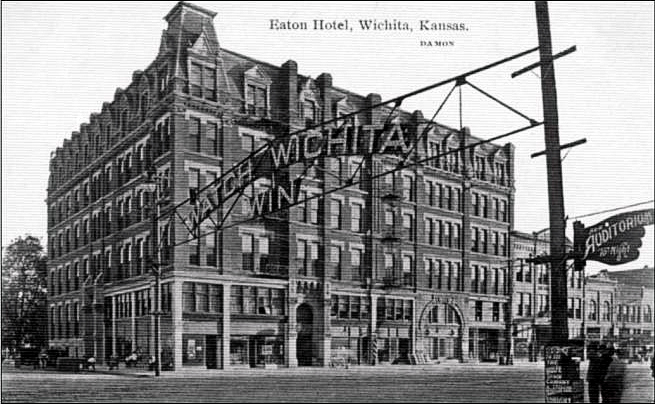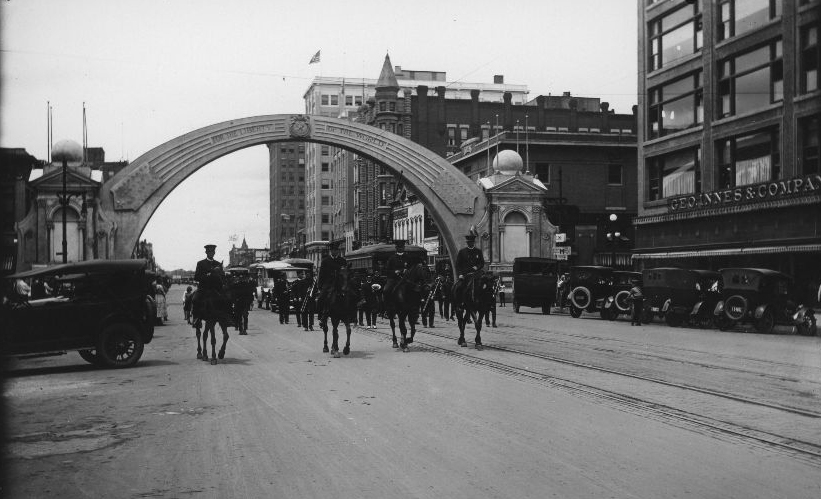WICHITARCHAEOLOGY by Michael Carmody

Arches Over Douglas
Douglas Avenue is the aorta to our fair city's heart, and as such, through boom and bust and boom again, has frequently been the focus of efforts among the city fathers (and mothers) to boost civic pride and patriotism. Today we find it divided into historic districts primarily distinguished by different varieties of shopping opportunities; in the 1960s and '70s the watchword was "urban renewal" and a concerted effort was made to remove blighted blocks of buildings and clad remaining structures in modern facades (which ironically have aged much more tragically than the original architecture they obscure). But in the early part of the 20th century, nothing said "progress" like a gigantic arch straddling the city's widest street.
In August 1909 the city commission, at the behest of Mayor C.L. Davidson, ordered an electric sign to be fabricated and erected at the corner of Douglas & St. Francis, where it could be seen from the train tracks by incoming visitors. The sign was to have flashing letters three feet high spelling out WATCH WICHITA WIN, and would be illuminated each evening from dusk through midnight. A scant month later, on September 18, the sign was installed and switched on, swelling the hearts of local tradesmen and no doubt impressing the hell out of rubes from smaller neighboring burgs.
At the time, Douglas and other downtown streets were cobbled with a nightmarish tangle of wooden poles, each spiderwebbed with wires variously dedicated to electrical current, telegraph and telephone signals and streetcar voltage; in addition gas piping was abundant due to the preponderance of gaslights still in use from the pre-electric era. And so it came to pass in 1912 that the city took steps to this clutter away and update the streetscape to a more modern, clean "white way" system of electric streetlamps. The "Watch Wichita Win" sign was lowered from its antiquated wooden posts and raised again on new iron poles. The Wichita Business Association agreed to pay half the cost of this procedure.
Changing times bring changing attitudes, and within a year the city and the WBA mutually decided they were tired of paying the electric bill for the massive flashing sign, and it went dark. Soon after followed discussion of taking the sign down altogether, though just a few months later, in spring of 1914, the business association asked the city to consider turning the lights back on again. It was not to be. On August 25, 1914, after five years of service, the sign was unceremoniously taken down at 1:00 in the morning by a crew utilizing the fire department’s "aerial motor truck."

But Wichita's flirtation with arch-ery was not yet finished. World War I broke out the next year and when the armistice came in November 1918, the city's civic leaders once again felt compelled to erect a span across Douglas, this time at its intersection with Lawrence Street (now known as Broadway). The Victory Arch was conceived as a welcome-home tribute to local troops returning from service in the ghastly Great War and when built dwarfed the spindly "Watch Wichita Win" sign.
Architect Don Buel Schuler, who had been Frank Lloyd Wright's site architect on the Allen-Lambe House project, designed the 40-foot-high Victory Arch; it was constructed of wood and finished in white stucco. $6400 of the $8200 budget for the arch was raised through donations from citizens, with the remaining $1800 being provided by civic booster Walter Vincent, who would go on to become a founding member of the Wichita Art Association the following year. The arch, emblazoned with the slogan FOR THE LIBERTY OF THE WORLD, was finished just in time for a massive parade on May 9, 1919. 105,000 spectators packed both sides of Douglas Avenue, cheering the returning troops.
The Victory Arch was never intended to be permanent, and a few months after the homecoming parade, area businessmen began to tire of the giant obstacle, which obscured visibility and snarled traffic at one of the city's busiest intersections. In January 1920 a petition was submitted to the city asking that the arch be dismantled. There was talk of moving it to Riverside Park, but this was quickly deemed unfeasible. By March, it was decided that the memorial would be razed, according to the Wichita Beacon, "as soon as Walter Vincent, who promoted the building of the arch, is reimbursed $1,800." In August 1920 the deed was done, and Douglas Avenue has ever since been archless.